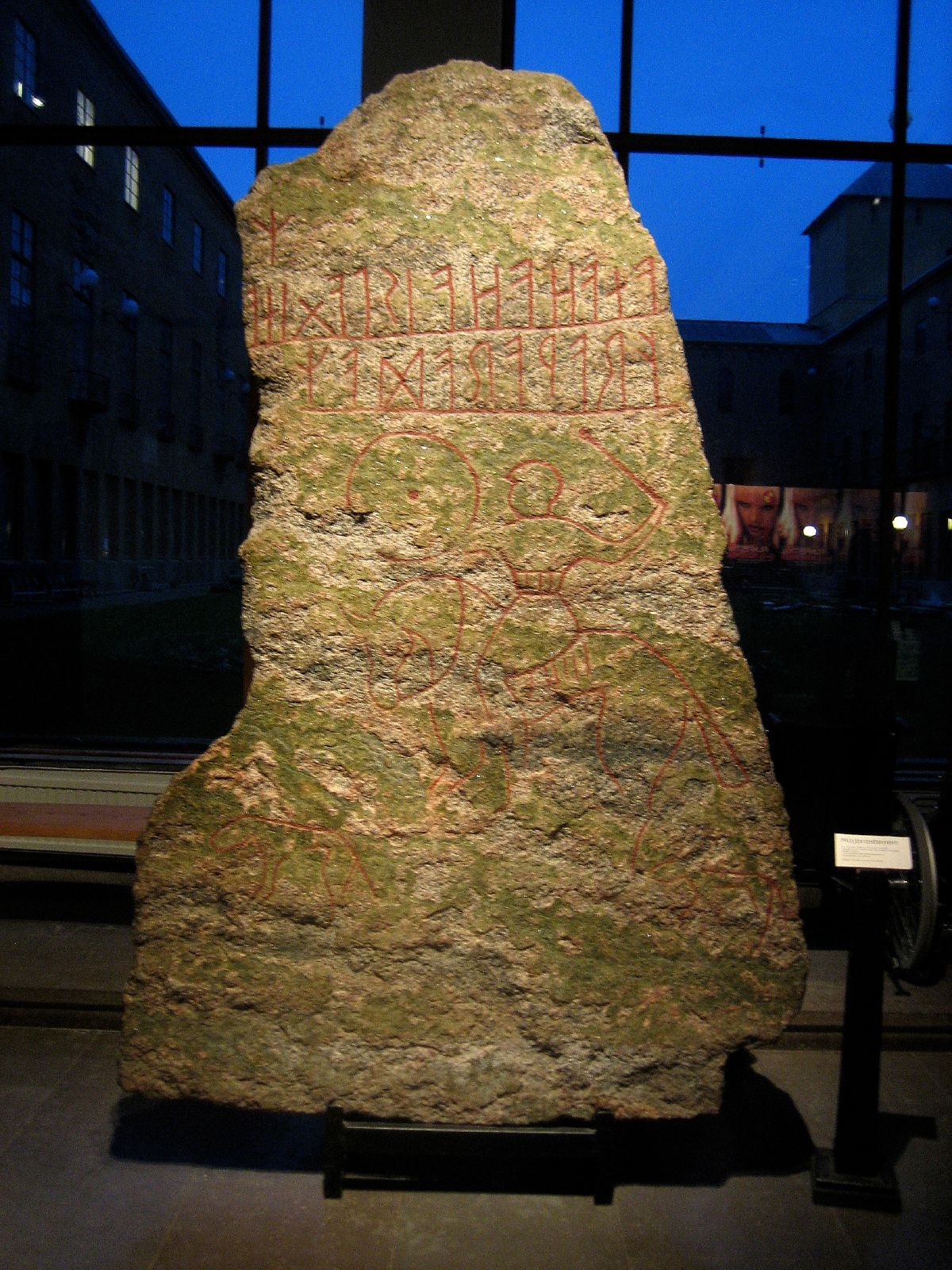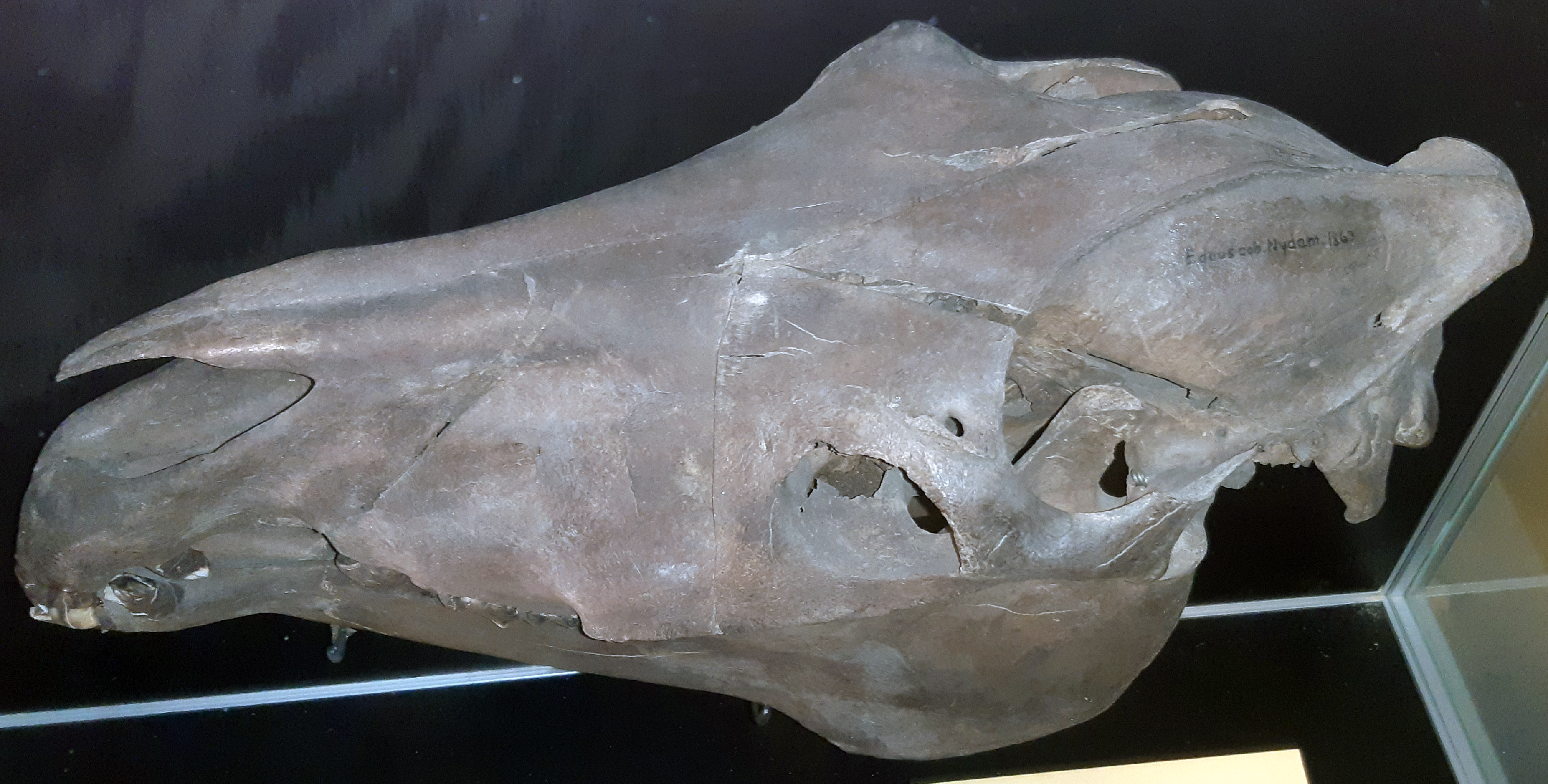|
Möjbro Runestone
The Möjbro Runestone is a runestone that is designated as U 877 in the Rundata catalog and is inscribed in Proto-Norse using the Elder Futhark. It was found in Möjbro, which is about 8 kilometers north of Örsundsbro in Uppsala County, Sweden, which is in the historic province of Uppland. The runestone is on display at the Swedish Museum of National Antiquities in Stockholm. Formerly placed in the 3rd century, the inscription and drawing are now mostly placed in the 5th or early 6th centuries. History Although the stone has been known since the initial surveys of runestones in Sweden during the 1600s, its exact original location is not known. The runestone is in height and made of granite. It is considered to be fragile. To protect the stone and its shallow inscription, it was moved in 1948 from Möjbro to the Swedish Museum of National Antiquities. Drawing The Möjbro Runestone is notable not only for being one of few runestones in Proto-Norse, but also for showing what is c ... [...More Info...] [...Related Items...] OR: [Wikipedia] [Google] [Baidu] |
Uppland Rune Stone U 877
Uppland () is a historical province or ' on the eastern coast of Sweden, just north of Stockholm, the capital. It borders Södermanland, Västmanland and Gästrikland. It is also bounded by lake Mälaren and the Baltic Sea. On the small uninhabited island of Märket in the Baltic, Uppland has a very short and unusually shaped land border with Åland, an autonomous province of Finland. The name literally means ''up land'', a name which is commonly encountered in especially older English literature as ''Upland''. Its Latinised form, which is occasionally used, is ''Uplandia''. Uppland is famous for having the highest concentration of runestones in the world, with as many as 1,196 inscriptions in stone left by the Vikings. Administration The traditional provinces of Sweden serve no administrative or political purposes, but are historical and cultural entities. The corresponding administrative county, or ', is Uppsala County, which occupies the larger part of the territory. The ... [...More Info...] [...Related Items...] OR: [Wikipedia] [Google] [Baidu] |
Roman Cavalry
Roman cavalry (Latin: ''equites Romani'') refers to the horse-mounted forces of the Roman army throughout the Regal, Republican, and Imperial eras. In the Regal era the Roman cavalry was a group of 300 soldiers called '' celeres'', tasked with guarding the king. Later their numbers were doubled to 600, then possibly 1,800. All of the cavalrymen were patricians. In the Republican era, the general name for the cavalry was Equites and consisted of the Equites class and the First Class, with a group of 300 cavalrymen in every legion. They were divided into 10 groups of 30 men. Each group elected three leaders known as ''decuriones''. Later the Roman cavalry stopped using Roman citizens as cavalrymen and relied on Auxilia and foreign recruits. Roman cavalrymen wore a Corinthian helmet, bronze chestplate, and bronze greaves. Later mail was adopted into the army. Their arms included a lance ('' lanceae''), a long sword (''spatha''), and short throwing spears (''akontes''). Hist ... [...More Info...] [...Related Items...] OR: [Wikipedia] [Google] [Baidu] |
Proto-Norse Language
Proto-Norse (also called Ancient Nordic, Ancient Scandinavian, Ancient Norse, Primitive Norse, Proto-Nordic, Proto-Scandinavian and Proto-North Germanic) was an Indo-European language spoken in Scandinavia that is thought to have evolved as a northern dialect of Proto-Germanic in the first centuries CE. It is the earliest stage of a characteristically North Germanic language, and the language attested in the oldest Scandinavian Elder Futhark inscriptions, spoken from around the 2nd to the 8th centuries CE (corresponding to the late Roman Iron Age and the Germanic Iron Age). It evolved into the dialects of Old Norse at the beginning of the Viking Age around 800 CE, which later themselves evolved into the modern North Germanic languages ( Faroese, Icelandic, the three Continental Scandinavian languages, and their dialects). Phonology Proto-Norse phonology probably did not differ substantially from that of Proto-Germanic. Although the phonetic realisation of several phonemes ... [...More Info...] [...Related Items...] OR: [Wikipedia] [Google] [Baidu] |
Nationalencyklopedin
''Nationalencyklopedin'' (; "The National Encyclopedia" in English), abbreviated NE, is a comprehensive contemporary Swedish-language encyclopedia, initiated by a favourable loan from the Government of Sweden of 17 million Swedish kronor in 1980, which was repaid by December 1990. The printed version consists of 20 volumes with 172,000 articles; the Internet version comprises 260,000 articles (as of June 2005). History The project was born in 1980, when a government committee suggested that negotiations be initiated with various publishers. This stage was finished in August 1985, when in Höganäs became the publisher responsible for the project. The project specifications were for a modern reference work based on a scientific paradigm incorporating gender and environmental issues. Pre-orders for the work were unprecedented; before the first volume was published in December 1989, 54,000 customers had ordered the encyclopedia. The last volume came out in 1996, with three suppl ... [...More Info...] [...Related Items...] OR: [Wikipedia] [Google] [Baidu] |
List Of Runestones
There are about 3,000 runestones in Scandinavia (out of a total of about 6,000 runic inscriptions). p. 38. The runestones are unevenly distributed in Scandinavia: The majority is found in Sweden, estimated at between 1,700 and 2,500 (depending on definition). Denmark has 250 runestones, and Norway has 50. There are also runestones in other areas reached by the Viking expansion, especially in the British Isles ( Manx runestones, Page, Raymond I. (1995). Runes and Runic Inscriptions: Collected Essays on Anglo-Saxon and Viking Runes'. Parsons, D. (ed.) Woodbridge: Boydell Press, 207–244 England runestones, Scotland and Ireland) and other islands of the North Atlantic (Faroes, Greenland, but not in Iceland), and scattered examples elsewhere (the Berezan' Runestone in Eastern Europe, Pritsak, O. (1987). ''The Origin of Rus'.'' Cambridge, Mass.: Distributed by Harvard University Press for the Harvard Ukrainian Research Institute. Sawyer, Birgit. (2000). The Viking-Age Rune-Stones: ... [...More Info...] [...Related Items...] OR: [Wikipedia] [Google] [Baidu] |
Horse Sacrifice
Horse sacrifice is the ritual killing and offering of a horse, usually as part of a religious or cultural ritual. Horse sacrifices were common throughout Eurasia with the domestication of the horse and continuing up until the spread of Abrahamic religions, or in some places like Mongolia, of Buddhism. The practice is rarely observed in some cultures even today. Many ethnic religions from Indo-European speaking peoples show evidence for horse sacrifice, and comparative mythology suggests that they derive from a purported Proto-Indo-European ritual and common root, though the practice is also observed among non-Indo-European speaking peoples, especially in nomadic societies from the Eurasian steppe. Context Horses are often sacrificed in a funerary context, and interred with the deceased, a practice called horse burial. There is evidence but no explicit myths from the three branches of Indo-Europeans of a major horse sacrifice ritual based on a speculated mythical union of Indo- ... [...More Info...] [...Related Items...] OR: [Wikipedia] [Google] [Baidu] |
Bind Rune
A bind rune or bindrune ( is, bandrún) is a Migration Period Germanic typographic ligature, ligature of two or more Runic alphabet, runes. They are extremely rare in Viking Age inscriptions, but are common in earlier (Proto-Norse) and later (medieval) inscriptions.Enoksen, Lars Magnar (1998). ''Runor: historia, tydning, tolkning'', p. 84. Historiska Media, Falun. On some runestones, bind runes may have been ornamental and used to highlight the name of the carver. Description There are two types of bind runes. Normal bind runes are formed of two (or rarely three) adjacent runes which are joined together to form a single conjoined glyph, usually sharing a common vertical stroke (see ''Hadda'' example below). Another type of bind rune called a same-stave rune, which is common in Scandinavian runic inscriptions but does not occur at all in Anglo-Saxon runes, Anglo-Saxon runic inscriptions, is formed by several runic letters written sequentially along a long common stemline (see '' ... [...More Info...] [...Related Items...] OR: [Wikipedia] [Google] [Baidu] |
Early Runic Stone Hagby Möjebro Uppland Sweden - Right To Left Script
{{disambiguation, geo ...
Early may refer to: History * The beginning or oldest part of a defined historical period, as opposed to middle or late periods, e.g.: ** Early Christianity ** Early modern Europe Places in the United States * Early, Iowa * Early, Texas * Early Branch, a stream in Missouri * Early County, Georgia Other uses * ''Early'' (Scritti Politti album), 2005 * ''Early'' (A Certain Ratio album), 2002 * Early (name) * Early effect, an effect in transistor physics * Early Records, a record label * the early part of the morning See also * Earley (other) Earley is a town in England. Earley may also refer to: * Earley (surname), a list of people with the surname Earley * Earley (given name), a variant of the given name Earlene * Earley Lake, a lake in Minnesota *Earley parser, an algorithm *Earley ... [...More Info...] [...Related Items...] OR: [Wikipedia] [Google] [Baidu] |
Swedish National Heritage Board
The Swedish National Heritage Board ( sv, Riksantikvarieämbetet; RAÄ) is a Swedish government agency responsible for World Heritage Sites and other national heritage monuments and historical environments. It is governed by the Ministry of Culture. The goals of the agency are to encourage the preservation and protection of historic environments and to promote the respect for and knowledge of historic environments. In order to do this, it tries to ensure that Swedish heritage is accessible to all citizens, to spread information about that heritage, and to "empower heritage as a force in the evolution of a democratic, sustainable society". History 17th and 18th century The National Heritage Board was founded in 1630. On the 20May that year, Johannes Bureus who was a prominent rune researcher and King Gustavus Adolphus' private teacher, was appointed the first ''riksantikvarien'' ("National Antiquarian"). Bureus' teachings had made the king interested in ancient monuments an ... [...More Info...] [...Related Items...] OR: [Wikipedia] [Google] [Baidu] |
Fornvännen
''Fornvännen'' ("The Friend of the Distant Past"), ''Journal of Swedish Antiquarian Research'' is a Swedish academic journal in the fields of archaeology and Medieval art. It is published quarterly by the Royal Swedish Academy of Letters, History and Antiquities in Stockholm, Sweden. The journal's contributions are written in the Scandinavian languages, English, or German with summaries in English. The editor-in-chief is Mats Roslund. The Editorial Board practices double blind peer review with external reviewers. ''Fornvännen'' began publication in 1906 when it replaced two earlier journals, ''Svenska Fornminnesföreningens Tidskrift'' and ''Vitterhetsakademiens Månadsblad''. Early contributors included noted archaeologists Oscar Montelius and Hans Hildebrand. Stig Welinder has noted that the journal included articles by women from an early stage, including those of Rosa Norström and Sigrid Leijonhufvud, and characterises this as part of the women's rights movement in Sweden. ... [...More Info...] [...Related Items...] OR: [Wikipedia] [Google] [Baidu] |
Late Antiquity
Late antiquity is the time of transition from classical antiquity to the Middle Ages, generally spanning the 3rd–7th century in Europe and adjacent areas bordering the Mediterranean Basin. The popularization of this periodization in English has generally been credited to historian Peter Brown, after the publication of his seminal work '' The World of Late Antiquity'' (1971). Precise boundaries for the period are a continuing matter of debate, but Brown proposes a period between the 3rd and 8th centuries AD. Generally, it can be thought of as from the end of the Roman Empire's Crisis of the Third Century (235–284) to the early Muslim conquests (622–750), or as roughly contemporary with the Sasanian Empire (224–651). In the West its end was earlier, with the start of the Early Middle Ages typically placed in the 6th century, or earlier on the edges of the Western Roman Empire. The Roman Empire underwent considerable social, cultural and organizational changes starting wit ... [...More Info...] [...Related Items...] OR: [Wikipedia] [Google] [Baidu] |



